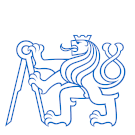154TELS Terrestrial laser scanning: Porovnání verzí
m (→Anotation) |
|||
| Řádek 11: | Řádek 11: | ||
==Anotation== | ==Anotation== | ||
The course is intended for students interested in 3D terrestrial laser scanning. The main topics are basic principles and theory of laser scanning systems, basic types of terrestrial and aerial laser scanners and overview of selected laser scanning systems, influences on measurement accuracy, general procedure of measurement processing (point cloud processing), practical use in surveying, architecture, construction and related fields, introduction to selected software for point cloud processing, economic benefits. | |||
; | ;Acknowledgement | ||
# | Online learning support for flexible teaching of new courses of the Geodesy and Cartography programme taught in English (105 1052201A003 FCE) | ||
;Recommended literature | |||
# Shan, J. – Toth, Ch. K.: Topographic Laser Ranging and Scanning: Principles and Processing. 1st Edition. CRC Press, 2017, ISBN 9781315219561. | |||
# Vosselman, G. – Mass, H. G.: Airborn and Terrestrial Laser Scanning. Dunbeath: Whittles Publishing, 2010, pp. 318, ISBN 978-1904445-87-6. | |||
# Heritage, G. – Large, A.: Laser Scanning for the Environmental Sciences. Wiley-Blackwell, 2009, ISBN 978-1-405-15717-9. | |||
# Reshetyuk, Y.: Terrestrial laser scanning: Error sources, self-calibration and direct georeferencing. Saarbrucken, Tyskland : VDM Verlag Dr. Muller, 2009, ISBN 9783639175509. | |||
# Kašpar, M. – Pospíšil, J. – Štroner, M. – Křemen, T. – Tejkal, M.: Laser Scanning in Engineering and Land Surveying. Vega, Hradec Králové, 2005, ISBN 80-900860-7-1 | |||
==Lectures== | ==Lectures== | ||
Verze z 4. 1. 2023, 12:43
Basic Information
- Up-to-date and complete information - OFFICIAL WEBSITE
- Code: 154TELS
- Lectures: Ing. T. Křemen, Ph.D.
- Practical classes: Ing. T. Křemen, Ph.D. (head of the classes),
- lectures per week: 2 hours
- exercises per week: 2 hours
- Credits: 6
- finished with: an exam
- winter and summer semester
Anotation
The course is intended for students interested in 3D terrestrial laser scanning. The main topics are basic principles and theory of laser scanning systems, basic types of terrestrial and aerial laser scanners and overview of selected laser scanning systems, influences on measurement accuracy, general procedure of measurement processing (point cloud processing), practical use in surveying, architecture, construction and related fields, introduction to selected software for point cloud processing, economic benefits.
- Acknowledgement
Online learning support for flexible teaching of new courses of the Geodesy and Cartography programme taught in English (105 1052201A003 FCE)
- Recommended literature
- Shan, J. – Toth, Ch. K.: Topographic Laser Ranging and Scanning: Principles and Processing. 1st Edition. CRC Press, 2017, ISBN 9781315219561.
- Vosselman, G. – Mass, H. G.: Airborn and Terrestrial Laser Scanning. Dunbeath: Whittles Publishing, 2010, pp. 318, ISBN 978-1904445-87-6.
- Heritage, G. – Large, A.: Laser Scanning for the Environmental Sciences. Wiley-Blackwell, 2009, ISBN 978-1-405-15717-9.
- Reshetyuk, Y.: Terrestrial laser scanning: Error sources, self-calibration and direct georeferencing. Saarbrucken, Tyskland : VDM Verlag Dr. Muller, 2009, ISBN 9783639175509.
- Kašpar, M. – Pospíšil, J. – Štroner, M. – Křemen, T. – Tejkal, M.: Laser Scanning in Engineering and Land Surveying. Vega, Hradec Králové, 2005, ISBN 80-900860-7-1
Lectures
Lecturer:
